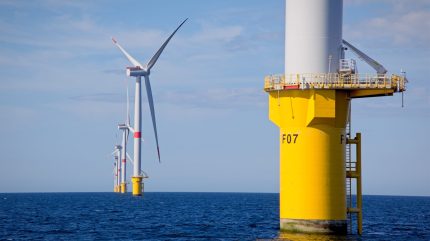
A feasibility study by Oasis Marine, commissioned by Scottish Power Renewables, has declared that offshore charging technology is a viable solution for electric vessels used for crew transfer to offshore wind farms.
Oasis Marine looked at decarbonisation efforts by operators of offshore wind farms, which have grown in popularity in Europe as governments and consumers demand more non-fossil fuel energy supply.

Discover B2B Marketing That Performs
Combine business intelligence and editorial excellence to reach engaged professionals across 36 leading media platforms.
The company confirmed that its own offshore charging technology could be efficiently used by wind farm operators. The “Oasis Power Buoys” could reduce costs and emissions if paired with electric crew transfer vessels, Oasis Marine concluded.
“Oasis Power Buoys… allow vessels to charge while moored to the buoy and also power down propulsion, minimising required charging time and maximising energy
savings,” the report claimed.
Currently, traditional fuel service vessels are used to transport crews when human intervention is required for maintenance, for example.
“The logical and most efficient zero-emission fuel for the wind farm maintenance vessels to use is the electricity the wind farm itself generates,” the report pointed out.

US Tariffs are shifting - will you react or anticipate?
Don’t let policy changes catch you off guard. Stay proactive with real-time data and expert analysis.
By GlobalDataThe “Power Buoys” can be moored close to wind turbines and connected via an “umbilical” to a “Power Supply Unit” installed on the base of the turbine. “The Oasis Power Buoy acts both as a mooring point for the vessel and as a distribution point for the electricity and data communications” according to Oasis Marine.
The study suggested that for a 1GW wind farm in the North Sea, 30nm from a port, two of the “power buoys” could supply power for three electric crew transfer vessels.
Ross Ovens, ScottishPower Renewables’ managing director for offshore, said: “These latest studies have the potential to help the industry take a step closer to a new era for offshore wind farm operations – not just here in the UK, but right across the globe.”
The report was shared via Operation Zero, an initiative launched at COP26 by “developers and supply chain companies committed to making zero-emission operations and maintenance vessels a reality.”
Leo Hambro from the Operation Zero Steering Committee said: “It’s great to see developers and the supply chain working together to develop the solutions and best practice that will be a game changer for the industry as a whole. Through studies like these, we will be able to learn, innovate and accelerate the adoption of zero-emission vessels and technologies to achieve a sustainable maritime future.”
You can read the report here.





